The piece of the month of December 2017
THE PICTORIAL ENSEMBLE BY DIEGO DÍAZ DEL VALLE IN THE "NEW" SACRISTY OF THE CHURCH OF SAN MIGUEL ARCÁNGEL IN LARRAGA (NAVARRA) (1803)
Igor Cacho Ugalde
graduate in History
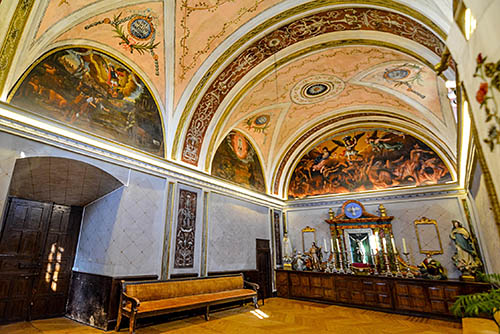
Interior of the "new" sacristy. F. Ignacio Yoldi
During the Middle Ages average many churches did not have a sacristy and the modest trousseau they had was kept in pews or cupboards in the vicinity of the altars. With the arrival of the Renaissance, great ensembles became widespread, such as Bramante's San Satyr in Milan and those of San Lorenzo in Florence, designed by Bruneleschi and Michelangelo respectively. The sacristy housed the cult trousseau, the priests were dressed and the procession of entrance was organised for the different services to be held. Moving forward in time and focusing on the Navarrese area, during the Baroque period those of Tudela Cathedral and the parishes of Lerín, Arróniz, Viana, Villafranca, San Cernin in Pamplona, Larraga, Falces and Mendigorría were built.
PARISH OF LARRAGA
The church of San Miguel Arcángel de Larraga is a temple of medieval origin that acquired its current configuration with the Renaissance enlargement that took place between the 16th and 17th centuries. It included the first of the sacristies that exist today. Later, coinciding with the change of style, the Baroque, the temple was embellished with several altarpieces and architectural works such as the tower (1748-1761), the portico (mid-18th century) or the refurbishment of a large part of the choir (organ, tribunes, choir stalls, lectern and window; 1775-1803). The culmination of all this came with the construction of the "new" sacristy (1797, 1798-1803).
Architecturally, the "new" sacristy was built behind the chancel, to the east of the church, next to the "old" sacristy, between 1797 and 1798. It is a large rectangular room covered by two sections of half-barrel vaults with lunettes. The work was designed by Francisco de Sabando, a fundamental architect in the introduction of academic architecture. After construction, the sacristy was decorated and furnished with numerous objects and a set of paintings by Diego Díaz del Valle, Juan José Rey and Miguel de Zufía (1797-1803). Thus, on 31st December 1802, the board of trustees commissioned Diego Díaz de Valle, a resident of Cascante, to paint the room. The ensemble is made up of three canvases and several frescoes.
DIEGO DÍAZ DEL VALLE
The "new" sacristy in Larraga was decorated by Diego Díaz del Valle. According to R. Fernández Gracia, he was a discreet and cultured painter, but his work was widely dispersed geographically throughout Navarre. In addition to easel painting with devotional images, he produced perspective monuments, large pictorial ensembles, galleries of royal portraits, such as the portrait of the kings of Navarre executed for Pamplona Town Hall (1797), isolated royal portraits for Tudela Town Hall and the new sacristy of Tudela Cathedral (1783). He also produced a number of architectural designs for the chapel of San Fermín in Pamplona, the interior of Pamplona town hall and a number of neoclassical altarpieces.
ICONOGRAPHIC AND DECORATIVE PROGRAMME
Regarding the frescoes, Díaz del Valle committed himself to "the three half-point oil canvas paintings for the sacristy of the stories and apparitions of the Glorious St. Michael the Archangel as Patron of the same church in which will be painted, first and principally, the battle of the good and bad Angels as described in the Apocalypse, in the second the Apparition of St. Michael on Mount Gargano as described in the official document of his day, and in the third that which happened on Mount Aralar as described in the history of Don Teodosio de Goñi". The latter would be done "because it is in this Kingdom".
The battle of St. Michael would be "as described by St. John in the twelfth chapter, seventh verse". The miracle of Mount Gargano "as it is brought by its sections in the prayer". And the apparition of St. Michael on Mount Aralar "as expressed in his work by Father Burgui". The three oil paintings on canvas would have a diameter of seven rods in height and three and average in half point. All these textual indications place us before a learned and erudite painter.
With this status, in the first place we have Saint Michael slaying the devil, located in the north lunette. In the painting we can see the moment when, according to the Apocalypse, a resplendent Saint Michael, accompanied by two angels, slays the devil in hell. Alongside the demon are several figures who are consumed by fire. In the upper part there is a legend with the following registration: "ET FACTUM EST PRAELIUM EST PRAELIUM MAGNUM IN COELO MICHAEL ET ANGELI EJUS PRAELIABANTUR CUM DRACONE ET DRACO PUGNABAT ET ANGELI EJUS" "APOCALIPSIS CP XII, 7-9" In the lower part of the painting appears the sign of the painter "D. DIAZ DEL VALLE PINXIT 1803".

St. Michael slaying the devil. F. Ignacio Yoldi
In second place we find the Navarrese story of San Miguel de Aralar, located in the right lunette west. According to the legend, Teodosio was a knight who, after returning from the fight against the Arabs, was deceived by the devil and committed a crime. After that, the Pope absolved him but imposed him as penance to drag thick chains until, by a divine miracle, he was released. Theodosius retired to Aralar and according to the legend, one day he saw a great dragon coming out of a chasm that threatened to devour him. Theodosius, helpless, fell to his knees and implored the protection of St. Michael. At that moment the Archangel appeared, who, showing the cross above his head, defeated and killed the dragon. At that moment, Theodosius was freed from his chains and forgiven by God. The painting captures this moment. In the upper part we find the following registration: "CONCUSSUM EST MARE ET CONTREMUIT TERRA UBI ARCHANGELUS MICHAEL DESCENDEBAT DE COELO". Behind Theodosius appears the signature of the author "VALLE PINXIT 1803".
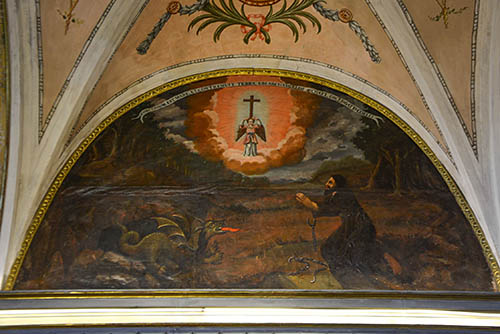
San Miguel de Aralar. F. Ignacio Yoldi
Finally, the painting above the entrance door depicts the Miracle of Mount Gargano. It is about an event that took place in 490 AD in Siponto (Italy), according to which there was a man called Gargano who had several herds of sheep as well as some bulls and oxen. One day, one of the oxen got lost and he found it at entrance in a cave. Thinking that it had been injured and could not move, Gargano decided to kill it by shooting it with a poisoned arrow. But as the wind changed direction, the arrow flew towards him and stuck him in the eye. The event spread among the people and reached the ears of the bishop, who, in view of the people's fear, ordered three days of fasting and supplications so that God would show his will. At the end of three days, Saint Michael appeared to the bishop and informed him that he was the protector of the cave. And as the custodian of the place where he had decided to dwell, he had deflected the arrow. Finally, the bishop and the inhabitants of the city made a pilgrimage to cima, prostrating themselves as a sign of respect for Saint Michael. Like the other canvases, at the top we have the following registration: "MICHAEL ARCANGELE VENI IN ADJUTORIUM POPULO DEI". On a stone under the arch of Gargano appears the author's sign "VALLE PINXIT".

The miracle of Mount Gargano. F. Ignacio Yoldi
In addition to the three main canvases, the sacristy has an interesting decorative ensemble. Firstly, in the open spaces next to the windows, several frescoes with natural themes were painted, depicting trees, forests and small landscapes with farmhouses. Secondly, a plinth was placed on the side walls to prevent the paintings from being damaged by saltpetre or damp. A starry sky was painted above the plinth. Thirdly, the two half-barrel vaults with lunettes were painted according to the following description of the contract: "all the tempera painting of the vaults, vault strips (?), openings, plinths of the sacristy where various ornaments of grotesques, links of flowers and allegorical things and the same stories of the half-points or allusive to the sacristy itself are to be painted, giving their openings the corresponding half-colours".
A circle with a star is painted in the central space. On the other hand, all the edges of each end and the central part are covered with a white band delimited by a moulding. In the lunettes there are four medals with palms and bows containing invocations. In the south vault, in the west lunette we can read: "DEI NUNTIUS PRO ANIMABUS IUSTIS". In the east: "VENIT IN ADJUTORIUM POPULO DEI". In the north vault, in the west lunette we can read: "QUIS SICUT DEUS". In the east: "SALUS DEO NOSTRO".
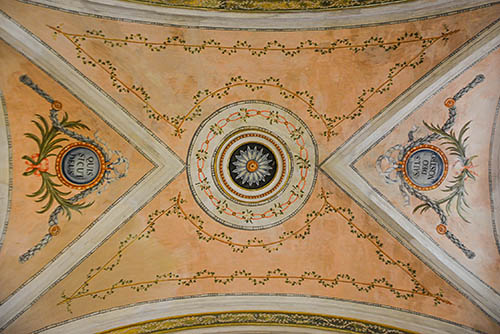
Paintings of the north vault. F. Ignacio Yoldi
The fourth decorative element was the pilasters. Architecturally, the ensemble is made up of three pilasters. In the centre there is a larger one and the other two are on either side of the sacristy. In the contract signed with Diego Díaz del Valle, it was established that "they are to be painted with half-colours, grotesque ornaments, scalloped links and other appropriate elements, all in tempera".
In general, the decoration is in keeping with academicism and is reminiscent of the frescoes of antiquity. Broadly speaking, we can point out the following characteristics of the ensemble. Firstly, the pictorial pilasters are framed by two smaller pilasters on the sides. These lateral pilasters are gilded and contain vegetal interlacing. Secondly, within the pictorial pilasters, it should be noted that the central one is not only larger in size but also contains a different theme than the lateral ones. And thirdly, both the central pilaster and the pictorial side pilasters are different in terms of theme from their continuation on the perimeter walls.
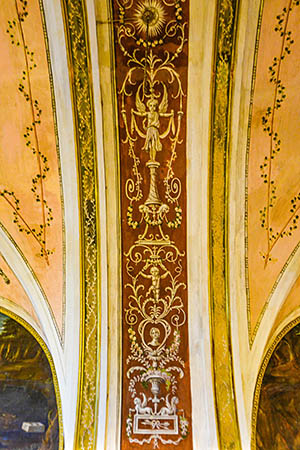
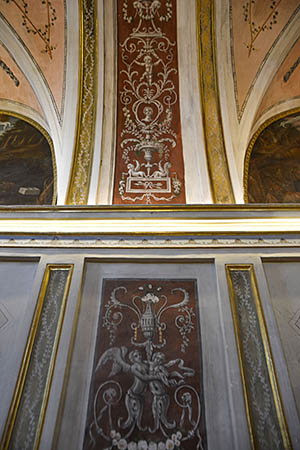
Decorative motifs on the central pilaster. F. Ignacio Yoldi
SOURCES AND BIBLIOGRAPHY
- file Diocesan of Pamplona, Parish Archives, Parish Church of San Miguel Arcángel de Larraga.
- file General of Navarre, Notarial Protocols, Notary of Larraga, Ramón Barricarte.
- FERNÁNDEZ GRACIA, R, Diego Díaz del Valle: a painter from Cascante in the Age of Enlightenment, report 2013 of the Chair de Patrimonio y Arte Navarro, 2014, pp. 84-87.
- FERNÁNDEZ GRACIA, R. (coord.), El Arte del Barroco en Navarra, Government of Navarre, 2014.
- FERNÁNDEZ GRACIA, R., La sacristía de la catedral de Pamplona. Use and function. Los ornamentos, Príncipe de Viana, 217, pp. 349-382.
- SERRANO SAGASETA DE ILÚRDOZ, I., El cuadro de las almas del purgatorio de la parroquia de Sesma, obra de Diego Díaz del Valle, Chair de Patrimonio y Arte Navarro, Pieza del mes, November 2016, http://www.unav.edu/web/catedra-patrimonio/classroom-abierta/pieza-del-mes/2016/noviembre
